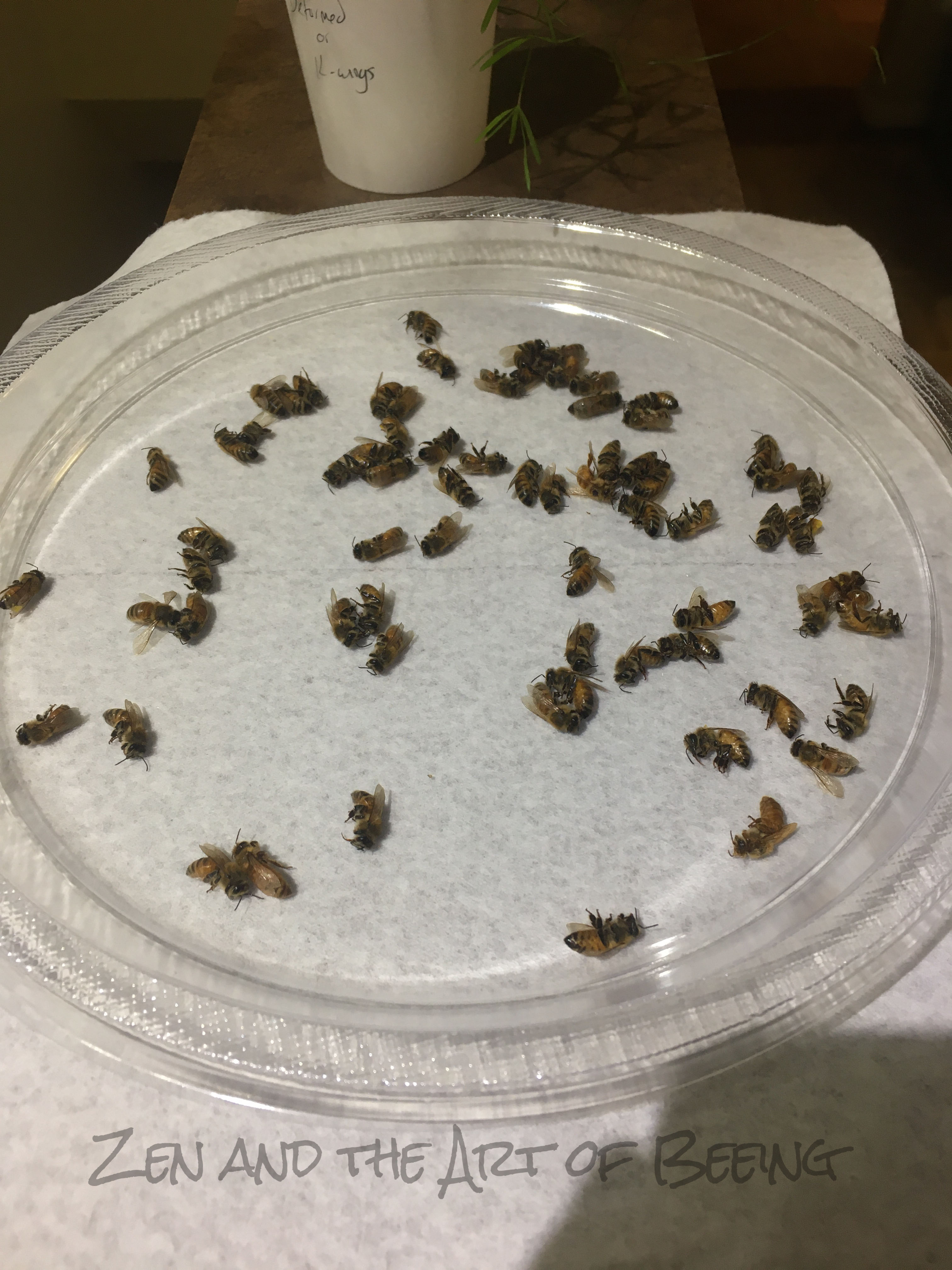
I recently wrote about the hive autopsy I performed on New Years Eve 2020, when I determined that my colony didn’t make it because they were just too small to generate the heat required to make it through our winter nights; their small size likely caused by a rough year as well as varroa problems. But I didn’t share the rest of the story!
Because I’m kind of geeky about bees, I had collected all of the bees from the hive autopsy for further examination and brought them inside in some cups. I wanted to look at them closer, get more photos for those bees that appeared to have some deformed or K wings, and perhaps preserve my queen in epoxy (or make swarm attractant queen pheromone by preserving her in alcohol).

Several hours later, I pulled the queen out of the cluster cup and held her in my hand to look at her. Suddenly, I saw the slightest movement of a leg! I thought it must be some sort of post-mortem reflex, or that I had accidentally pressed on her in such a way that caused the movement. But then, every time I gently lifted her legs they would move ever-so-slightly back and forth. I looked into the cluster cup and saw the faintest movement from several other bees…They weren’t dead!!! I was absolutely giddy with excitement. I dumped the cup out onto a plate and over the next several hours watched as some of the cluster bees slowly came back to life. I also marked the queen since that was easy to do with her in this state.
Apparently, this is not unheard of! I found a forum thread about this exact thing, where most (if not all) of the posts also had this happen in winter with very small clusters the beekeeper thought were dead. I think most of the posts discovered movement while they were still working their hives; mine didn’t start moving that fast though – this was hours later in a 70 degree house when the very slightest movement became visible.
At cooler temperatures, honeybees go into something called “torpor” which is a state of reduced metabolism, kind of like hibernation. So, my cluster was chilled, probably close to the point of death (and would have gotten there during the below freezing nights to come), but not quite there. From the temperature sensor in my hive, I know it got down to around 17 degrees F just above the cluster the night before I found them.
I was hopeful that they would be able to fully revive themselves, so as their movement increased, I felt like I needed to contain them somewhere so I didn’t have a bunch of loose bees in the house. I moved them into an old package container with a chunk of honeycomb so I could continue to observe. At one point, I dipped a toothpick in honey to try to feed the queen since what remained of her colony wasn’t paying her any attention, and she actually took a little bit. (Is a sign of a “crazy bee lady” attempting to hand-feed a queen bee? Maybe.)

By the morning of January 2nd, the queen bee and several others were walking and eating. While most of the bees so far had been ignoring the queen, I noticed one or two that were with her appearing to groom her, so that was an improvement. They all still seemed fairly weak, no flying and only one or two were making any buzzing sound. Actually the queen seemed to be in the best shape – she was walking around the most. I suppose that’s no surprise since she was in the middle of the cluster; out of all the bees coming back to life, she was probably the most protected from the cold temperatures.
At this point, I knew the colony still might not make it. The bees that survived seemed weak and unable to do much, and there were only 10-12 bees that were walking around. But as long as the queen was alive, I wanted to see what would happen and give them the best chance I could. After a day and a half in the package box in a warm room in my house (I tried keeping them in the cooler basement, but that made them all stop moving again!), I moved all the living bees into a homemade push-in queen cage on a frame from their hive, and put that into a nuc box.

My main concern now was that the worker bees were just not tending to the queen very much; I was worried that she would starve. I took advantage of a warm-enough winter day to quickly pull a frame off my other colony and shake it into the nuc to boost the population, and then waited to see if those bees would accept this queen in a few days and help feed her. I stapled screen along the roof of the nuc so that I could still watch.

Unfortunately, on January 3rd I found the queen dead in the queen cage. I’m unsure whether the foreign bees killed her through the cage (there are no signs of mauling or bite marks on her body, though), if she was just too damaged from the chill, or if she starved or got dehydrated because the worker bees from her colony weren’t feeding her. In the end, there were only 7 worker bees from the original colony who were still alive on Jan 3rd.
I learned quite a few lessons from this experience. If I could do it all over again, I would change a few things:
- I should have kept the population-boost bees separated with a double screen within the nuc for a few days until they would accept a new queen. Being limited on available equipment, as well as good weather days that bees could be pulled from the other hive, I didn’t have much choice as to when I grabbed them and how I stored them. I didn’t think of this until later, but making a double screen or double layer queen cage would have at least have let me know for sure whether the population-boost bees killed her or if she died from other causes.
- I should not have provided chunks of honeycomb or drops of honey. It was too sticky and I had to keep helping the weak bees get un-stuck! Next time, I would provide a normal sugar water feeding station instead.
- Going back to the very beginning when I found the seemingly-dead small colony, since the cluster was still on the frames, I shouldn’t have started a hive autopsy yet. Next time, I will bring the frames containing the cluster inside for a day in a screened nuc or observation hive, and see if warming brings them back. (Oh – and I should have an observation hive! That would have made a lot of things with this easier.)
- As I was planning what I would do to keep this colony warm and alive through the rest of winter, I realized the delicate balance of temperatures required. Keeping them inside the house would be too warm – they would want to fly around and possibly start raising brood. That maybe would have been ok, except they would also need a way to leave for cleansing flights. If I kept them outside, they would have been too small to survive super chilled nights.
- Had the small colony revived itself with the workers tending to the queen, I probably would have tried keeping them inside in a cool place like the garage for nights and cold days and moving them out for days warm enough for flight. A little labor intensive, but I work from home so much these days that it could have been done. Another option would have been buying and setting up an observation hive with outside access. In either case, I would have addressed adding brood and young bees to boost their population once spring comes.
- I learned that a zombee queen is very easy to mark while she’s still coming back to life!
A lot of beekeepers probably wouldn’t bother trying to continue to save a colony this weak, but I think it would have been cool to see if they could possibly bounce back. I’m especially curious if the queen was even still fertile and able to lay eggs, or if her reproductive ability was damaged in the chill, and am looking forward to researching what correlations between temperature and queen fertility have been found to exist.
The whole thing was an interesting experiment, and I was so excited when I thought they may still have a chance. It’s a bummer to lose a hive, and certainly extra sad to lose it twice. But I learned a lot, and even had the chance to actually see the queen feed herself from the chunk of honeycomb in the package, which I didn’t think queens would do! I hope something from what I tried and learned may help someone else in the same situation one day.
All in all, I suppose this means my last piece of advice for anyone inspecting a dead-out is: Make sure it truly is a dead-out!
Have you ever had a similar experience with your bees? Did your colony bounce back? What should I have done differently? Please share your stories in the comments below.


My dear crazy bee lady!Is this what you were like when your bees began to move?
https://www.youtube.com/watch?v=0VkrUG3OrPc
My life, being a musical, brought that to mind for me!, Love, YoMum
Haha! Yes that is EXACTLY what it was like!
My dear amazingsaving -our precious-Earth Awesome Treasure-thiscomment isn’t related to zombees, butI couldn’t see where else to say how muchI love your new branding! great job!It’s very nice!Your usual Outstanding effort!
Aw thanks!